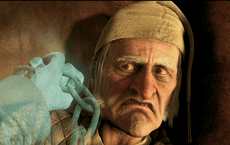
A Christmas Carol
Disney, PG
Charles Dickens' A Christmas Carol is not much of a novel when compared to the rest of that legendary writer's catalogue. Modern versions barely manage to run 90 pages"”a mere drop in the bucket next to Dickens' massive The Pickwick Papers (890 pages).
Pushed to name one of his works, the average person would more likely offer Oliver Twist or A Tale of Two Cities.
Although A Christmas Carol was critically acclaimed, disappointing sales meant it paid only a fifth of what its struggling author had hoped to earn from it. Yet for all that, this postcard of a story from 1843 has so wound itself around the hearts of the Western world that its chief character, Scrooge, has become a byword for both the meanest behaviour imaginable and the most heartfelt repentence.
Disney isn't attempting anything terribly new by releasing its animated version of A Christmas Carol this holiday season. Even as a cartoon, Jim Carrey is a perfect fit for the miserly Ebenezer who steals the coins from the eyes of his dead partner because, after all, "Tuppence is tuppence!" The decision to employ motion capture techniques also means that the production preserves Carrey's signature style of physical acting.
But, no, writer-director-producer Robert Zemeckis definitely did not have 'new' in mind. The dialogue is almost lifted word for word from the original novel. Even the 3D animations reflect the wood engravings that accompanied the first edition. Most importantly, Dickens' key idea has been lovingly preserved - and it makes for a discordant carol this Christmas.
Thanks to the Muppets and many others, the tale of Scrooge has taken on the air of a pantomime. Yet it is one of the wonders of the modern age that people can listen to a story a hundred times over and still not hear its main point.
A Christmas Carol has been retold at least that often in its 166-year history. Storybooks, cartoons, tele-movies"”even operas!"”have taught us about the skinflint businessman who is visited by three spirits on the night before Christmas that coax and terrify him into changing his ways. Hollywood itself has reminded us more than 20 times with Laurence Olivier, Bill Murray and Marcel Marceau all claiming their share of the limelight. However the original author had more than encouraging generosity in mind when he put pen to paper.
Charles Dickens was a strong voice for the downtrodden and the poverty-stricken"”his own father had been carted off to debtor's prison when he was 12, and the family had joined him there after they could no longer make ends meet.
At the time he wrote A Christmas Carol the Poor Law Amendment Act had been in force for nine years, creating workhouses across England for those who could no longer afford to feed themselves. And popular publications like the Essay on the Principle of Population had convinced many who were better off that a man who had no job or inheritance had "no claim of right to the smallest portion of food, and, in fact, has no business to be where he is".
But any version of A Christmas Carol that stops at encouraging people to be generous at a time when many can be in want would not have pleased Dickens.
Disney and Dickens put the moral force of this latest production, not in the hearts of men but in the hands of powers beyond this world.
The Ghost of Christmas Past encourages Scrooge to remember the blessings he has enjoyed at this time of year thanks to other people. The Ghost of Christmas Present shows him the moving opportunities he has all around him to improve the lives of the suffering.
Yet the most convincing arguments for Scrooge come at the beginning and end of his tale.
His evening begins with an appearance by his deceased business partner Marley who has been condemned to an eternity of regret for his failure to care for his fellow man. In an interesting move for a feel-good franchise, Disney leaves in Marley's wail: "I wear the chain I forged in life ... link by link I forged it ... not to know that no space of regret can make amends for one life's opportunity misused!"
And at the darkest part of the night the Ghost of Christmas Yet to Come appears in the form of the Grim Reaper. Zemeckis has a hearse chase Scrooge down into a grave glowing with red light as a warning of what will happen if he does not change his ways. I was glad I didn't take my seven-year-old.
Kermit the frog might have melted Michael Caine's heart in A Muppet's Christmas Carol but in the end it was the opinion of the creator not the creature that turned Scrooge's heart.
Dickens and Disney's Tiny Tims both hope that those who feel pity for a poor crippled boy in church "... will think of Him who made lame men walk" at Christmas time.
This was a lesson that Dickens meant for adults, as well as children.
There is no separating the generosity we owe to others from the generosity God has shown to us by sending his son to give us new hearts. Christmas shouldn't just bring out the best in us once a year; it should transform our lives"”as it did for Scrooge. Dickens knew where he wanted to end his story, and finished it accordingly:
"Some laughed to see the alteration in [Scrooge] but he let them laugh ... he knew how to keep Christmas well, if any man alive possessed that knowledge. May that be truly said of us, and all of us! And so, as Tiny Tim observed, God bless us, every one!"
















